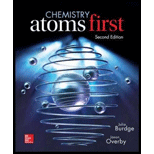
Concept explainers
(a)
Interpretation:
The name, empirical formula and character (covalent or ionic) of given compound should be identified.
Concept introduction:
A molecule is neutral group of two or more atoms joined together by
Ionic compound is a composed of ions held together by electrostatic forces called as ionic bond. The compound is neutral, it is of consists positively charged ions called cations and negatively charged ions called anions.
Compounds of metals with nonmetals are usually called as ionic, nonmetal-nonmetal compounds are usually molecular
(b)
Interpretation:
The name, empirical formula and character (covalent or ionic) of given compound should be identified.
Concept introduction:
A molecule is neutral group of two or more atoms joined together by chemical bonds.
Ionic compound is a composed of ions held together by electrostatic forces called as ionic bond. The compound is neutral, it is of consists positively charged ions called cations and negatively charged ions called anions.
Compounds of metals with nonmetals are usually called as ionic, nonmetal-nonmetal compounds are usually molecular
Want to see the full answer?
Check out a sample textbook solution
Chapter 5 Solutions
Chemistry: Atoms First
- 3. The skeleton of chloromethane is __________________ The central carbon atom is bonded to each of the other atoms by a shared electron pair (represented by a straight line, ___) giving Now, each hydrogen has two electrons and the carbon atom has eight. However, chlorine must be provided with unshared electrons (represented by pairs of dots, ) to complete its octet, thusarrow_forwardWhich of the following atoms would be expected to form negative ions in binary ionic compounds and which would be expected to form positive ions: Br, Ca, Na, N, F, Al, Sn, S, Cd?arrow_forwardFor elements in Groups 4A-7A of the periodic table, give the number of bonds an element is expected to form (in an uncharged molecule) if it obeys the octet rule.arrow_forward
- 7.74 In a lattice, a positive ion is often surrounded by eight negative ions. We might reason, therefore, that the lattice energy should be related to eight times the potential of interaction between these oppositely charged particles. Why is this reasoning too simpler?arrow_forwardwe would predict that the imaginary ionic compound XF would have a (higher /lower) lattice energy than YyF2 becausearrow_forwardOut from the following pairs, which of the compounds show properties of ionic compounds? a)NH3and BH3 b)PCl5and H2O c)KI and O3 d)RbCl and CaO e)NaF and H2O (2) The definition of the "Lattice Energy" is, a.The energy change that occurs when electrons are removed from a lattice. b.The energy change that occurs when a gas condenses to a liquid. c.The energy change that occurs when a liquid freezes. d.The energy change that occurs when an ionic solid is separated into its ions in the gas phase. e.The lattice energy of a substance is identical to the ionic bond energy determined from coulombs law.arrow_forward
- How many covalent bond(s) would the element germanium (Z = 32) be expected to form in order to obey the octet rule? Use the octet rule to predict the formula of the compound that would form between germanium and hydrogen, if the molecule contains only one germanium atom and only single bonds are formed.arrow_forwardConsider the following ions: NO2−NO2−, CO32−CO32−, and ClO4−ClO4−. For each of these, you should use a Lewis structure that satisfies the octet rule. Which of these ions will exhibit resonance among multiple equivalent Lewis structures that satisfy the octet rule?arrow_forwardI and Cl, state whether the binary compound they form is likely to be ionic or covalent. Then write the empirical formula and name of the compound.arrow_forward
- The chemical formula for the compound that forms between sodium and chlorine is NaCl, while the compound that forms between magnesium and chlorine is MgCl2. Explain this difference using the octet rule and the Lewis Dot Diagrams for each particle (Na, Cl, & Mg).arrow_forwardBased on formal charge considerations, which of the following would likely be the correct arrangement of atoms in sulfur dioxide: OSO or SOO?arrow_forwardUse condensed electron configuration and Lewis symbols to depict the formation of Mg2+ and Cl- ions from the atoms, and give the formula of the compound formed.arrow_forward
 Chemistry by OpenStax (2015-05-04)ChemistryISBN:9781938168390Author:Klaus Theopold, Richard H Langley, Paul Flowers, William R. Robinson, Mark BlaserPublisher:OpenStaxChemistry: Matter and ChangeChemistryISBN:9780078746376Author:Dinah Zike, Laurel Dingrando, Nicholas Hainen, Cheryl WistromPublisher:Glencoe/McGraw-Hill School Pub Co
Chemistry by OpenStax (2015-05-04)ChemistryISBN:9781938168390Author:Klaus Theopold, Richard H Langley, Paul Flowers, William R. Robinson, Mark BlaserPublisher:OpenStaxChemistry: Matter and ChangeChemistryISBN:9780078746376Author:Dinah Zike, Laurel Dingrando, Nicholas Hainen, Cheryl WistromPublisher:Glencoe/McGraw-Hill School Pub Co Chemistry: Principles and PracticeChemistryISBN:9780534420123Author:Daniel L. Reger, Scott R. Goode, David W. Ball, Edward MercerPublisher:Cengage Learning
Chemistry: Principles and PracticeChemistryISBN:9780534420123Author:Daniel L. Reger, Scott R. Goode, David W. Ball, Edward MercerPublisher:Cengage Learning
 Chemistry for Engineering StudentsChemistryISBN:9781337398909Author:Lawrence S. Brown, Tom HolmePublisher:Cengage Learning
Chemistry for Engineering StudentsChemistryISBN:9781337398909Author:Lawrence S. Brown, Tom HolmePublisher:Cengage Learning Chemistry & Chemical ReactivityChemistryISBN:9781133949640Author:John C. Kotz, Paul M. Treichel, John Townsend, David TreichelPublisher:Cengage Learning
Chemistry & Chemical ReactivityChemistryISBN:9781133949640Author:John C. Kotz, Paul M. Treichel, John Townsend, David TreichelPublisher:Cengage Learning





